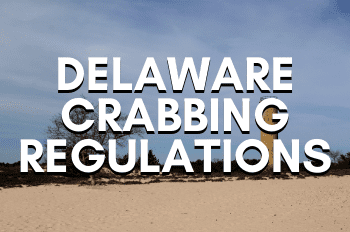Maryland Crabbing Regulations Casually Explained (Updated for 2020)
Before you even think of setting your traps in Maryland waters, it’s important that you know its crabbing regulations. All of which can be found on Maryland’s Department of Natural Resources website, but that’s in very formal lingo that’s no fun to decipher. So, I sorted through Maryland’s crabbing laws and organized them into this readable guide.
After reading this summary of Maryland’s crabbing guidelines, I recommend that you check out Maryland’s DNR website for more guidance. Only there will you find the most accurate, up-to-date information.
The purpose of this post is not to restate crabbing regulations, but to better inform people of what rules they need to follow while crabbing.
Guidelines
Maryland Crabbing Season
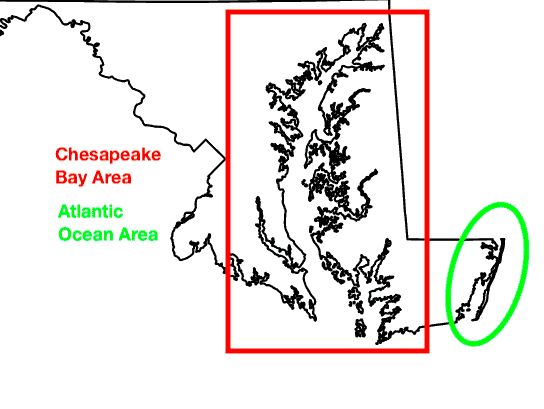
| Location | Legal Crabbing Dates |
|---|---|
| Atlantic Ocean Area | April 1 – December 31 |
| Chesapeake Bay Area | April 1 – December 15 |
Time of Day & Week Guidelines
Ready to go crabbing everyday? 7 days a week? I wish!
In Maryland, you are allowed to set up traps or catch blue crabs every day of the week except for Wednesday. The only exception to this rule is if a state or federal holiday falls on a Wednesday or Thursday.
You may also go crabbing on a Wednesday if you plan on going crabbing from your own a private property OR with a string, some bait, and a hand line.
Another thing to look out for is time of day restrictions.
Depending on the time of the year, you are allowed to go crabbing for certain hours of the day.
Time of Day Crabbing Regulations
| Location | Time of Year | Restricted Time to go Crabbing |
|---|---|---|
| Main Chesapeake Bay | May – September | 5pm – 1/2 before sunrise |
| Main Chesapeake Bay | April, October, November, December | 5pm – 1/2 after sunrise |
| Rivers, Creeks, Tidal Estuaries | May – September | Sunset and 1/2 before sunrise |
| Rivers, Creeks, Tidal Estuaries | April, October, November, December | Sunset and 1/2 after sunrise |
Source: Ch. 11 Season and Time for Catching Crabs – Maryland DNR
Size Limits
To preserve the blue crab population, state officials set measurements for what crabs you can keep. If you catch a blue crab and it’s too small, you must throw it back.
When you go crabbing, always bring a ruler with you to measure your crabs. You want to measure your crabs from the end of each point on their top shell. See the diagram below for reference:
Maryland Blue Crab Legal Size Regulations
| Type of Blue Crab | April 1 – July 14 | July 15 – December 31 |
|---|---|---|
| Hardshell Male Blue Crab | 5 inches | 5 1/4 inches |
| Soft-shell Blue Crab | 3½ inches | 3½ inches |
| Peeler Crab | 3¼ inches | 3½ inches |
| Mature Female Crab | No minimum size | No minimum size |
Which crabs can you keep?
If the crabbing day goes well, you’ll pull up lots of crabs in your traps. Each one will be in different stages of his or her crustacean life, but which ones can you keep?
In Maryland, you can keep both hard shell and soft shell blue crabs that are larger than the current set minimum size. Only individuals with a commercial crabbing license may keep mature female crabs, as long as they are not egg-bearing.
Well, what does that mean? How do you know a female crab is mature and not egg-bearing?
I wish I had pictures to better explain this, but I do not. I highly recommend you check out Bluecrab.info’s article on Crab Identification. There, you will find clear images that differentiate a sally, sook, and jimmy blue crab.
I’ll try to explain it. Identifying a blue crab is all in the abdomens. A male blue crab, also known as a Jimmy, has a narrow abdomen shaped like the Washington monument. An immature female blue crab, known as a Sally has a similarly-colored abdomen but it’s shaped like a ‘V’. Lastly, a mature female blue crab has a round, half-circle-shaped abdomen.
An egg-bearing female crab is easy to identify. An orange, spongy blog will protrude from her abdomen. These are her eggs, which slowly turn brown and hatch over a two-week time period.
Daily Catch Limits
As a recreational crabber, you can only keep a certain number of crabs while on a crabbing trip.
An in-depth table with Maryland’s daily catch limits can be found at Eregulations.com. Click the image below to see the table.

Gear Restrictions
Another thing to keep in mind is Maryland’s gear regulations. Depending on whether or not you have a crabbing license, you can use a limited amount of certain types of crab traps.
An in-depth table with Maryland’s gear restrictions can be found at Eregulations.com. Click the image below to see the table.
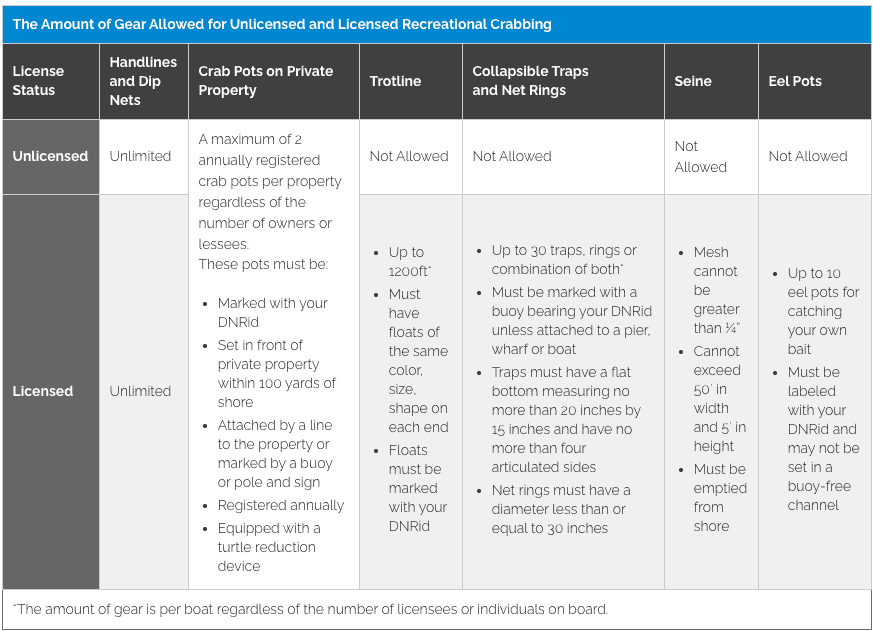
To summarize, An unlicensed individual can use an unlimited amount of hand lines and dip nets to go crabbing. A licensed individual can also use an unlimited amount of hand lines and dip nets, but also trotlines, collapsible traps, seines, and eel pots to go crabbing.
Also, You can use a crab pot to go crabbing in Maryland as long as the pot is registered, it’s being used from waterfront property that you own, and fits the current guidelines.
Need an example of each trap? Here they are.

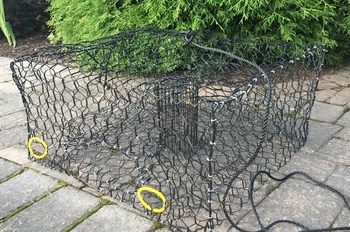
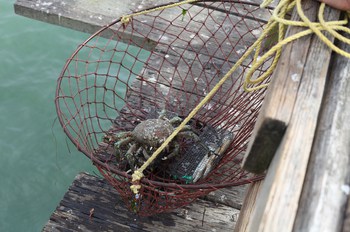
Crab Pot Regulations
If you’re a waterfront owner in the state of Maryland, a crab pot might be the trap for you. However, there’s a few hoops you’ll have to jump through.
Crab pots are one of the most regulated traps in Maryland. There are several specifications and terms of use for your crab pots that you must follow.
But don’t worry, I read the legal mumbo jumbo (which you can read at .07 Crab Pots) and transformed it into plain English. In fact, I made 5 steps you need to follow in order to legally use a crab pot in Maryland.
1) Own waterfront property to set your pot from, or have permission to do so from someone who does.
In order to preserve the blue crab population in hopes of reducing the number of lost crab pots, Maryland has highly regulated their use. In fact, you may not use a crab pot unless they are:
(i) An owner, lessee, or tenant of a private property along the shore; or
(ii) A guest of an owner, lessee, or tenant of a private property along the shore;
Maryland DNR
2) Check if your trap fits the current size requirements.
Depending on the shape of your trap, there’s a maximum size that recreational crabbers can
| Shape of Crab Pot | Max. Dimensions | Wire Mesh Min. Gap |
|---|---|---|
| Cube | 24″ Length 24″ Width 24″ Height | 1.5″ (for hardshell crabs) 1″ (for catching peeler crabs) |
| Rectangular | 48″ Length 24″ Wide 12″ Height | 1.5″ (for hardshell crabs) 1″ (for catching peeler crabs) |
3) If not there already, attach two cull rings to your crab pot.
Most traps come with cull rings. If not, this step is very important.
Cull rings are small plastic rings that fit on the sides of crab traps. Their purpose is to allow undersized crabs to escape your crab pot.
These are helpful to both you and blue crabs. While an undersized crab is not in your trap it’s out in the open water, growing meatier and producing more crabs along the way. Cull rings also prevent undersized crabs from cluttering your crab pot and stealing your bait.
4) Attach a turtle excluder device to each opening on your crab pot.
Something that lands a lot of crabbers is not having a turtle excluder on their crab pot. It’s a small square rectangle that makes your trap openings just a bit too small for the Diamondback Terrapin, a protected species of turtle, to enter your trap.
For information on how to install a turtle excluder, check out this Maryland DNR article.
5) Register your crab pot.
In order to use your crab pot, you need to register through Maryland’s Department of Natural Resources Compass System. This is different from an actual fishing license, which means you don’t get the benefits as a “licensed crabber.”
But no worries, it’s free and easy to sign up. Go to the link above to get signed up and check out Maryland’s DNR website for any questions you may have.
6) Get a buoy or marked flag.
The last regulation for crab pots in Maryland is a marked buoy or flag. In order to alert boaters of your crab pot, you must attach one to your trap.
This marker must be labeled with your DNRid number of your crabbing in the Bay or it’s connected rivers and streams. If you’re crabbing on the Atlantic side of Maryland, label it with your name and address.
Your pot must be set within 100 yards of shore in front of your waterfront property. I usually tie a long rope to my trap and tie the other end to a tree. Other options would be a private pier or piling in the water.
See my diagram below for reference:
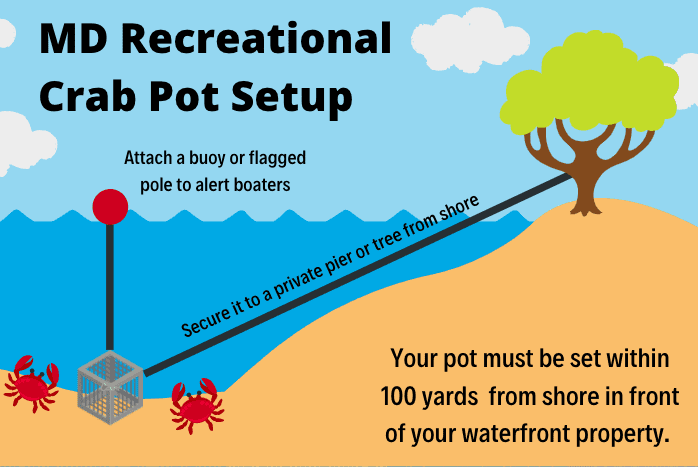
After this step, you are ready to hit the water! Happy crabbing!

